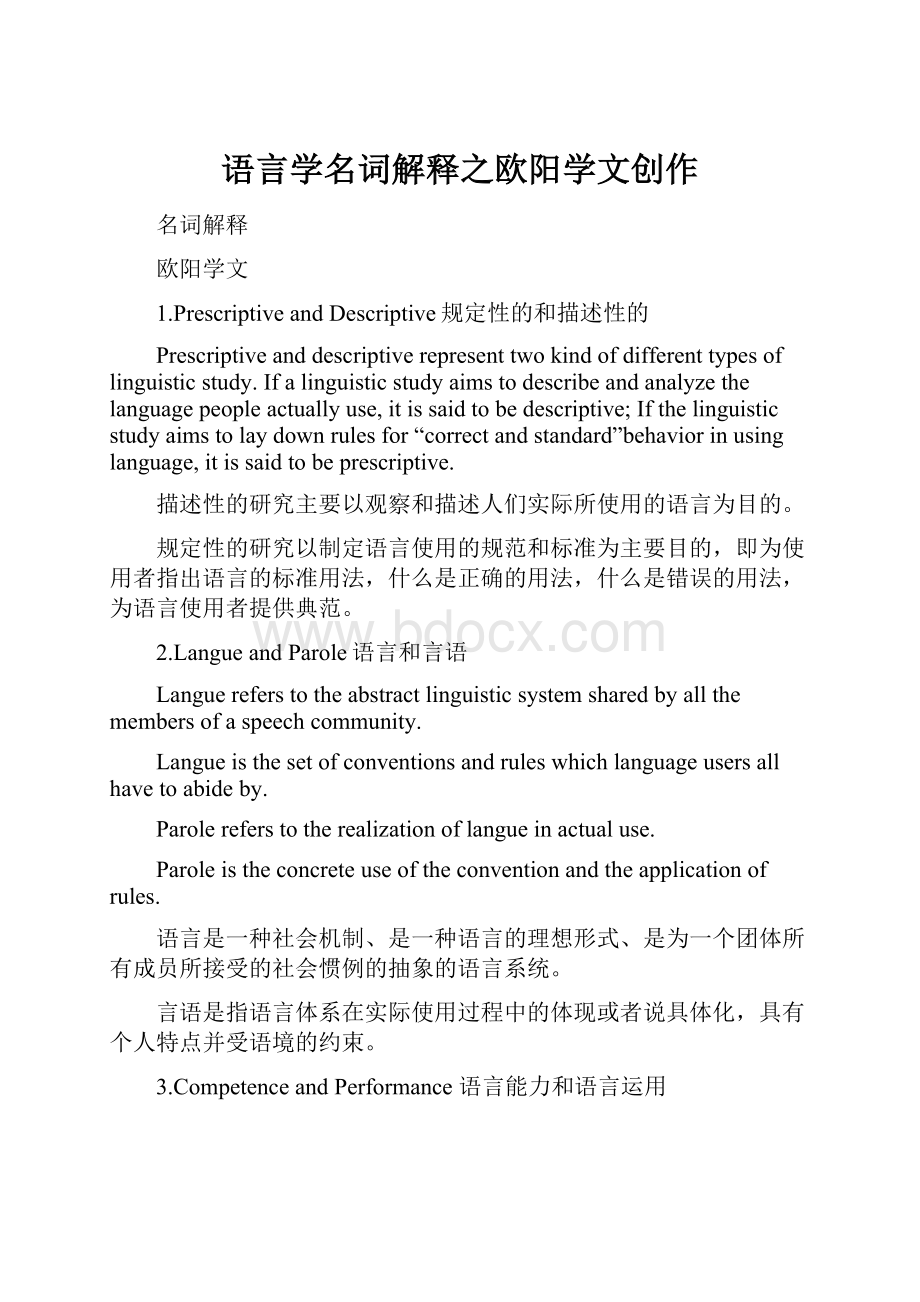语言学名词解释之欧阳学文创作.docx
《语言学名词解释之欧阳学文创作.docx》由会员分享,可在线阅读,更多相关《语言学名词解释之欧阳学文创作.docx(8页珍藏版)》请在冰豆网上搜索。

语言学名词解释之欧阳学文创作
名词解释
欧阳学文
1.PrescriptiveandDescriptive规定性的和描述性的
Prescriptiveanddescriptiverepresenttwokindofdifferenttypesoflinguisticstudy.Ifalinguisticstudyaimstodescribeandanalyzethelanguagepeopleactuallyuse,itissaidtobedescriptive;Ifthelinguisticstudyaimstolaydownrulesfor“correctandstandard”behaviorinusinglanguage,itissaidtobeprescriptive.
描述性的研究主要以观察和描述人们实际所使用的语言为目的。
规定性的研究以制定语言使用的规范和标准为主要目的,即为使用者指出语言的标准用法,什么是正确的用法,什么是错误的用法,为语言使用者提供典范。
2.LangueandParole语言和言语
Languereferstotheabstractlinguisticsystemsharedbyallthemembersofaspeechcommunity.
Langueisthesetofconventionsandruleswhichlanguageusersallhavetoabideby.
Parolereferstotherealizationoflangueinactualuse.
Paroleistheconcreteuseoftheconventionandtheapplicationofrules.
语言是一种社会机制、是一种语言的理想形式、是为一个团体所有成员所接受的社会惯例的抽象的语言系统。
言语是指语言体系在实际使用过程中的体现或者说具体化,具有个人特点并受语境的约束。
3.CompetenceandPerformance语言能力和语言运用
Chomskydefinescompetenceastheidealuser’sknowledgeoftherulesofhislanguage,andperformancetheactualrealizationofthisknowledgeinlinguisticcommunication.
乔姆斯基将语言能力定义为理想的用户对自己语言的规则的认识,并在语言交际中体现了这方面的知识。
语言运用是指一个人在自己的语言生成和理解过程中对语言知识的运用。
4.Language语言
Languageisasystemofarbitraryvocalsymbolsusedforhumancommunication.
语言是人类交际中使用的任意性的语音符号系统。
arbitrary[ˈa:
rbətreri]随意的
vocal[ˈvoʊkl]有声音的
5.Phonetics[fəˈnɛtɪks]语音学
Phoneticsreferstothestudyofthephonicmediumoflanguage;itisconcernedwithallthesoundsthatoccurintheworld’slanguage.
语音学:
它是研究语言的声音媒介的学科,即研究人类语言中所使用的全部语音的学科。
语音学研究的不是某一种特定的语言,而是用于所有人类的语音。
phonic[ˈfa:
nɪk]声学的,声音的,有声的medium[ˈmidiəm]媒介物,媒质
6.InternationalPhoneticAlphabet(IPA)国际英标
IPAreferstoastandardizedandinternationallyacceptedsystemofsymbolsusedtorepresentthespeechsoundsusedincommunication;theprincipleofIPAistouseoneletter(takenfromthemajorEuropeanlanguage)torepresentonesound.
IPA是一种规范和国际公认的用来表示语音通信中使用的符号系统;IPA的原理是用一个字母(从欧洲主要语言)来代表一个声音。
Standardized['stændədaɪzd]标准的,定型的
Alphabet[ˈælfəˌbɛt]字母表; 字母系统; 入门,初步
7.SuprasegmentalFeatures超切分特征
Suprasegmentalfeaturesrefertothosephonologicalfeaturesoccurringabovethesoundsegmentlevel.(ThemajorsuprasegmentalfeaturesinEnglisharestressandintonation.)
超音切分特征指的是语音特征出现以上的音段层面。
(英语中主要的超音段特征是重音和语调。
)
suprasegmental[ˌsu:
prəsegˈmentl]超音段的segment[ˈsɛgmənt]环节; 部分,段落
phonological[ˌfɒnə'lɒdʒɪkl]音系学的;(一种语言的)语音(或音位)体系的
8.Derivation派生词
Derivationisanaffixationalprocessthatformsawordwithameaningand/orcategorydistinctfromthatofitsbase.Onceformed,derivationwordsbecomeindependentlexicalitemsandreceivetheirownentryinaspeaker’smentaldictionary.
派生词是一种词缀转化的过程,将一个词缀-前缀或后缀-附在一个基本词(baseword)后,形成一个新的词,其词性可以改变,也可以不变。
一旦形成,派生词成为独立的词汇项目,并在一个演讲者的心理词典中获得自己的条目。
affixational词缀
category[ˈkætəgɔ:
ri]种类,类别
distinct[dɪˈstɪŋkt]明显的,清楚的
lexical[ˈlɛksɪkəl]词汇的
9.Syntax[ˈsɪnˌtæks]语法; 句法; 句法规则[分析]
Abranchoflinguisticsthatstudiesthesystemofrulesandcategoriesunderlyingsentenceformationinhumanlanguage,i.e.thestudyofhowwordscombinetoformsentencesandtheruleswhichgoverntheformationofsentences.
研究人类语言句子构成规则和范畴系统的语言学分支,即研究词如何组成短语和句子以及构成的规则。
10.Surfacestructure表层结构
Thestructurethatresultsfromapplyingtransformationalrulestoadeepstructure.
通过对深层结构进行转换而得到的结构。
11.Deepstructure深层结构
Anystructuregeneratedbythephrasestructurerulesofatransformationalgrammar.
由转换语法短语结构规则生成的结构。
Generated生成phrase[frez]短语
12.Reference所指
Referencemeanswhatalinguisticform( 语言形态)referstointhereal,physicalworld;itdealswiththerelationshipbetweenthelinguisticelement(语言要素)andthenon-linguisticworld(非语言世界)ofexperience.
“所指”是某一语言形式对现实世界中某一实体的指称。
它涉及的语言要素和非语言世界的经验之间的关系。
13.Conventionalimplicature规约含义
Conventionalimplicatureisbasedontheconventionalmeaningofcertainwordsinthelanguage;ortoputitinanotherway,conventionalimplicatureistheimpliedmeaningthatcanbeinferredfromtheconventionalmeaningofcertainwordsinthelanguage.
“规约含义”是指某些单词本身固有的、约定俗成的意义,不受语言外语境因素的影响。
(书上的)
“规约含义”是基于语言的某些词的传统意义或者把它以另一种方式表达出来。
规约含义是隐含的意义,可以从语言中的某些词的传统意义推断。
Implicature[ˈɪmplɪkətʃə(r)]含义
14.Standarddialect标准语
Thestandardvarietyisasuperimposed,sociallyprestigiousdialectoflanguage.Itisthelanguageemployedbythegovernmentandjudiciarysystem,usedbythemassmedia,andtaughtineducationalinstitution,includingschoolsettingwherethelanguageistaughtasaforeignorsecondlanguage.
标准品语是一种叠加的、具有社会声望的方言。
它是由政府和司法系统所使用的语言,由大众媒体使用,并在教育机构,包括由学校设置被教导作为外语或第二语言。
Superimposed使叠加
Prestigious[preˈstɪdʒəs]受尊敬的,有声望的
Judiciary[dʒuˈdɪʃieri]司法的
15.Culture文化
Culture,inabroadsense,meansintegratedpatternofhumanknowledge,belief,andbehaviorthatisbotharesultofandintegraltothehumancapacityforlearningandtransmittingknowledgetosucceedinggeneration.
Inanarrowsense,culturemayrefertolocalorspecificpractice,beliefsorcustoms,whichcanbemanifestedinfolkculture,enterprisecultureorfoodculture,etc.
文化,广义地说,是人类知识、信仰和行为的总称,是人类学习和传承知识的结果,同时也有助于人类知识的代代相传。
文化,狭义上说,是指一个地方性的或一种特别的做法。
信仰或习俗,常见于民俗文化、企业文化或饮食文化。
Integrated[ˈɪntɪgretɪd]完整的;整体的;结合的
Integral[ɪnˈtɛgrəl]完整的;积分的;必须的
Capacity[kəˈpæsɪti]n.容量;才能;性能;生产能力adj.充其量的,最大限度的
Manifest[ˈmænəˌfɛst]显示
16.Amalgamation文化混合[əˌmælgəˈmeʃən]
Amalgamation(orhybridization[ˌhaɪbrɪdaɪ'zeɪʃn])occurswhenasocietybecomesethnicallymixedinawaythatrepresentsasynthesisratherthantheeliminationorabsorptionofonegroupbyanother.
文化混合是指不同种族的群体生活在一起,形成一种综合的文化,既不是各种族的习俗被取消,也不是另一种族的习俗被接受,而是一种文化的混合。
Ethnically['eθnɪklɪ]adv.人种上,民族上
Synthesis[ˈsɪnθɪsɪs]n.综合
Absorption[əbˈsɔ:
rpʃn]n.吸收;专注;合并
17.Languageacquisition[ˌækwɪˈzɪʃən]母语习得
Languageacquisitionreferstoachild’sacquisitionofhismothertongue,i.e.howthechildcomestounderstandandspeakthelanguageofhiscommunity.Mostchildrenacquirelanguagequicklyandeffortlessly.Itseemsthattheiracquisitionprocessissimpleandstraightforwardandprocessatsimilarrate.
母语习得是指孩子们如何习得他们的母语,他们如何理解并会说自己的母语。
大多数儿童,不论其母语为何种语言,都可以很快地、毫不费力地学会自己的母语,而且他们语言发展的速度几乎同步。
Tongue[tʌŋ]语言
Community[kəˈmjunɪti]社区;社会团体;共同体
Straightforward[ˌstreɪtˈfɔ:
rwərd]直截了当地;坦率地
18.CriticalPeriodHypothesis[haɪˈpa:
θəsɪs](CHP)语言习得关键时期
EricLenneberg,abiologist,onthebasisofhisobservationofchildren’sabilitytodevelopbehaviorsandknowledgeinenvironments,arguedthattheLanguageAcquisitionDevice(LAD),likeotherbiologicalfunctions,workssuccessfullyonlywhenitisstimulatedattherighttime–aspecificandlimitedtimeperiodforlanguageacquisition–whichisreferredtoastheCriticalPeriodHypothesis(CHP).
生理学家EricLenneber在对正常儿童语言行为和知识发展观察的基础上,提出语言习得机制(LAD)作为一种生理机能在合适的或特定的时期内才能正常发挥作用,这个时期称之为语言习得关键时期(CHP)。
Stimulated['stɪmjəˌletɪd]起刺激作用,起促进作用
19.Interlanguage(IL),orlearnerlanguage中介语或学习者语言
AccordingtoSelinker’sdefinition(1972),interlanguageisdefinedasanabstractsystemoflearner’stargetlanguagesystem.Ithasnowbeenwidelyusedtorefertothelinguisticexpressions(语言表达)learnersproduce,especiallythewrongornotidiomaticones.
中介语或学习者语言,根据Selinker(1972)的定义,是指学习者产出的第二语言或外语。
现在它已经被广泛地用来指学习者产出的、与目标语标准形式有差异的语言。
Idiomatic[ˌɪdiəˈmætɪk]符合语言习惯的,成语的;含有习语的
20.Lateralization[ˌlætərəlɪ'zeɪʃən]偏侧优势
Lateralizationreferstotheunilateralcontrolovercognitivefunctionsbyeithertheleftortherightsideofthebrain.Forexample,languageisusuallyregardedtobecontrolledbythelefthemisphere.
大脑左半球对认知功能的单边控制称作偏侧优势。
如:
语言通常被认为由左脑控制。
Unilateral[ˌjunəˈlætərəl]单边的,一方的;单方有义务的;片面的;仅由一方实行或承担的
Cognitive[ˈka:
gnətɪv]认知的;认识的
Hemisphere[ˈhemɪsfɪr]半球;地球的半球;[解]大脑半球
21.Pragmatic语用学
Languagecommunicationdoesnotoccurinavacuum;italwaysoccursinacontext.Whenthestudyofmeaningisconducted,notinisolation,butinthecontextoflanguageuse,itbecomesanotherbranchoflinguisticstudycalledpragmatics.
语言交流不会发生在真空中,它总是发生在一个上下文中。
当意义的研究不是孤立的进行,而是在语言运用的语境中,它就成为语言学的另一个分支。
Vacuum[ˈvækjuəm]n.真空;空白;空虚;清洁
Conducted[kənˈdʌktɪd]控制